When and where
stadtprojektionen IV has taken place from September 17–20, 2020, at Drei Weieren, St.Gallen.
stadtprojektionen IV has taken place from September 17–20, 2020, at Drei Weieren, St.Gallen.
stadtprojektionen IV invites you to a nighttime stroll and watch above the city of St. Gallen. Drei Weiher nature park, a bathing and local recreation area will be the venue for the projections. Photo and film works will be shown at the idyllic bathing pavilions of Mannen- und Chrüzweier (ponds), on wooden footbridges and underneath the roof of restaurant Dreilinden.
Opening:
Thursday, September 17, 7 p.m., Kiosk in Familienbad, entrance via Dreilindenstrasse 50
Tours:
Friday, September 18, 8 p.m., entrance Familienbad (No. 14)
Sunday, September 20, 8 p.m., entrance Familienbad (No. 14)
The prelude to the fourth edition took place on August 27 at Frauenbad Stadthausquai in Zurich: Those arriving or departing can see a corporeal film work by BIGLERWEIBEL on the outer facade. At the edge of the recessed pool, just above the water surface, a text projection by Michèle Graf and Selina Grüter takes place. And in a changing room, animated figures by Bertold Stallmach can be observed – smooching, bathing, and encountering a sea monster.
The wooden bathhouses on the River Limmat and at Drei Weieren were built at around the same time. In terms of incorporation into the urban context and modern atmosphere, these bathing facilities present themselves very differently in the two cities: Drei Weieren is an intimate bathing facility surrounded by nature, while Frauenbad Stadthausquai is part of a vibrant city.
Herbert Bayer, Xanti Schawinsky in a Handstand Position, photograph, 1928
The Museum of Fine Arts, Houston. © Estate of Herbert Bayer / Artists Rights Society (ARS), New York
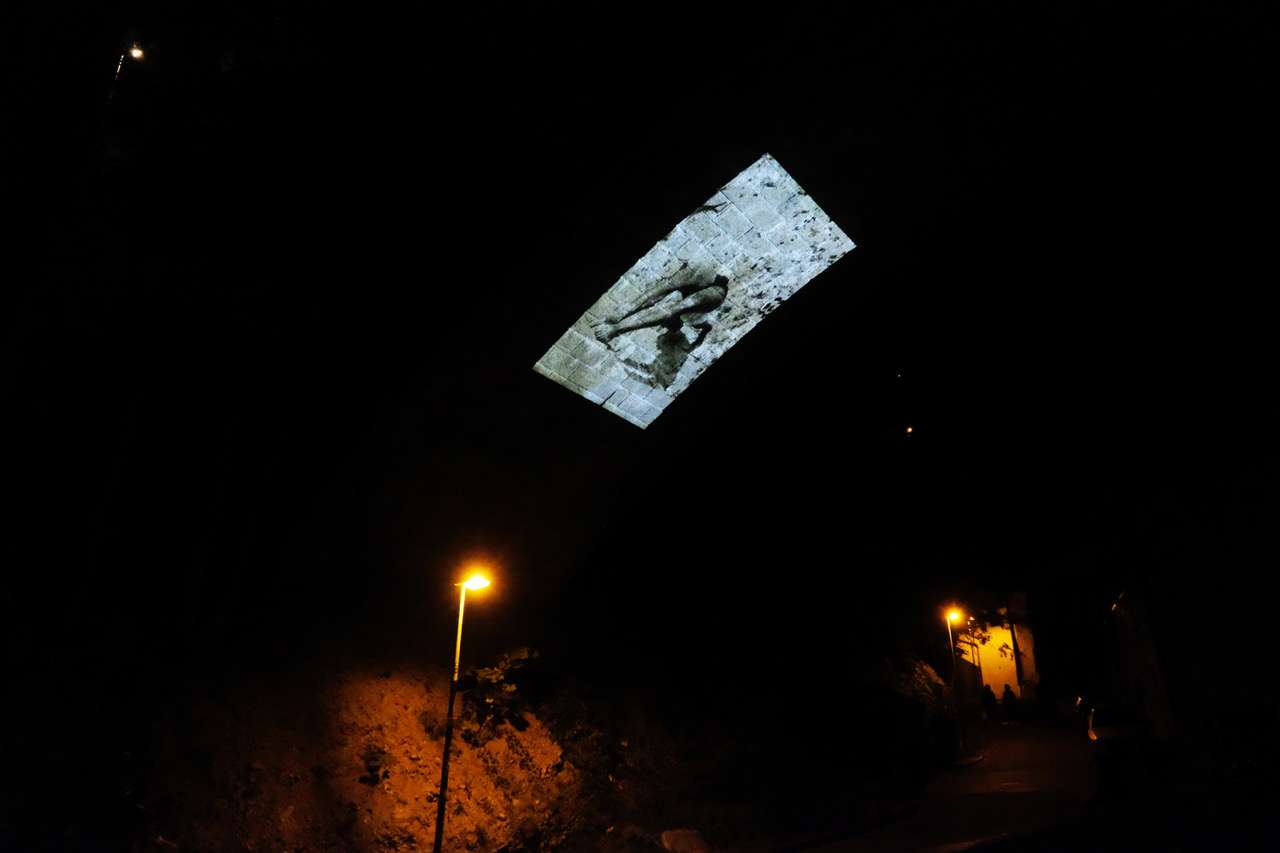
Under the stone bridge Felsenbrücke, amid the roaringly loud to and fro, a person can be seen doing a handstand. This black-and-white photograph was taken in 1928 by Herbert Bayer – photographer, teacher at the Bauhaus in Dessau and pioneer of graphic design. It shows artist Xanti Schawinsky doing a handstand on a beach, seen from above. The sand’s graininess becomes three-dimensional on Felsenbrücke’s natural stone. Due to the bold overhead view, Bayer’s photograph prompts a change in perspective and is a typical example of New Vision, a 1920s photographic movement, which broke with conventions by focusing on dynamic seeing and was practiced at the Bauhaus, for instance.
Engineer Robert Maillart built Felsenbrücke over Mülenen Gorge in 1903. Using reinforced concrete, which was a new material at the start of the 20th century, Maillart created pioneering bridges and mushroom slabs without beams. Felsenbrücke is one of Maillart’s early works. He ran a branch of his engineering firm in St. Gallen during the city’s embroidery boom. Unlike his later bridges, such as Salginatobel Bridge in Grisons, Felsenbrücke’s reinforced concrete structure is clad in natural stone – so although its core is radical, it still has a conformist exterior.
Double Keys, 2019, 6 min. 52 sec
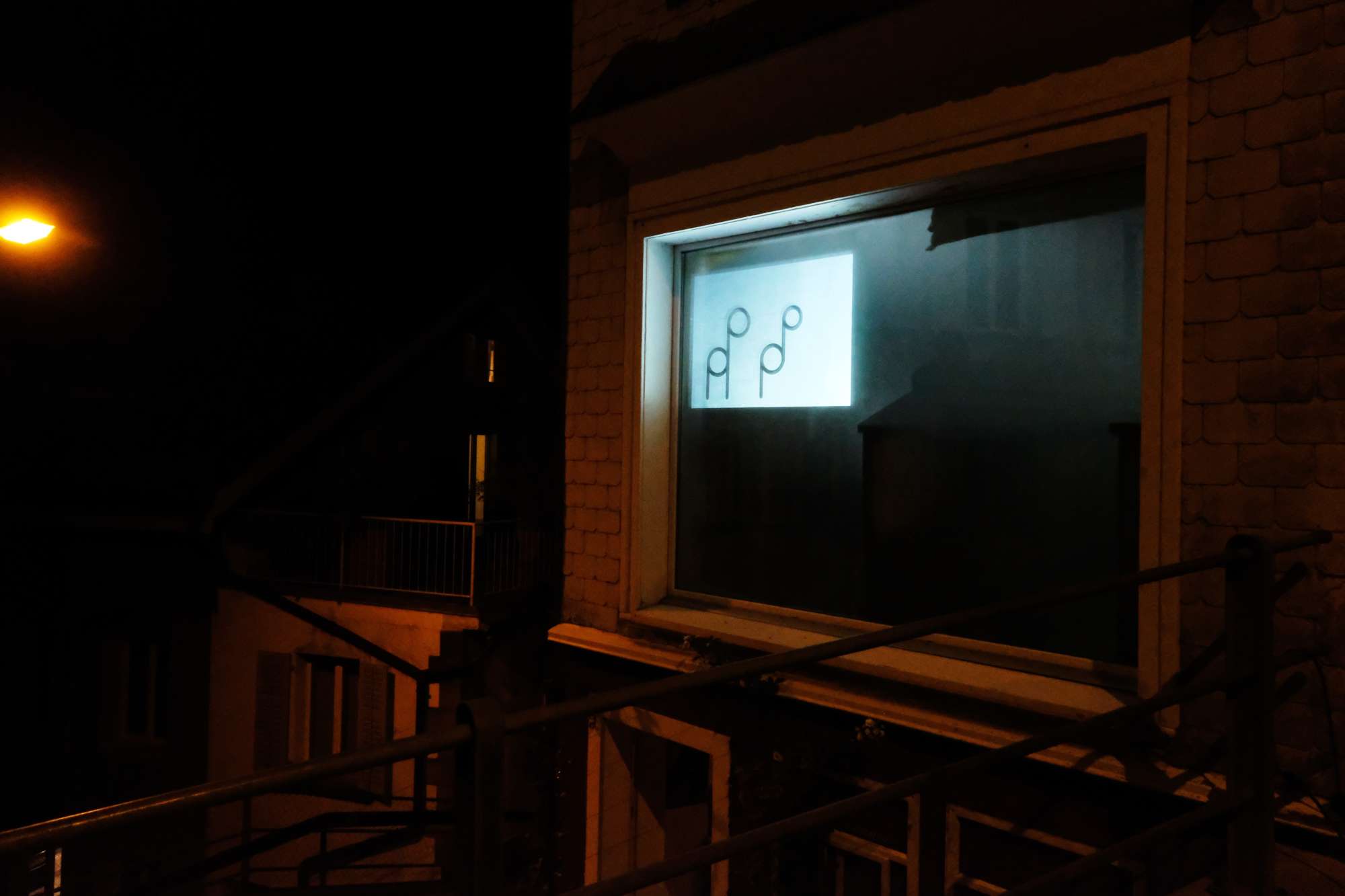
The video Double Keys by Salome Schmuki shines in the display window of Lukas Bar, which is encountered on the way from St. Georgen to Mülenen Gorge. We watch a screen, or to be precise, a digital text field. At first glance, we see cryptic symbols being typed, then deleted again: One symbol appears, then a second symbol in a modified form is typed, and perhaps even a third. Finally, all of them are deleted again and put into a new series, whereby the rhythm varies. Schmuki, an artist and graphic designer, designed this repertoire of symbols in 2017, based on English-language pronunciation models.
Her video also refers to the process of writing, the to and fro, back and forth, that takes place until a text emerges. Double Keys does not bring us to a final version. Instead, it is about the presentation of symbols and the sounds associated with them. As a result of zooming in closely, design-related aspects of symbols and letters come into view and questions arise: What does it take for us to be able to interpret letters and symbols?
Writing plays an important role at Mülenen Gorge, the setting of the legend surrounding Gallus and the founding of the city St. Gallen: Manuscripts used to be copied in the nearby scriptorium at the Abbey of St. Gall, the scribes inventing some symbols and spellings of their own in the process. At night, a neon text piece by artist Bethan Huws shines permanently at the Gottfried Keller Viaduct: Artists Interpret The World And Then We Interpret The Artists. Lastly, literature is of central importance to Lukas himself, who set up a library in his previous bar in the city centre a few years ago.
Bedenken, Teil 1: Sprache (Deliberation, Part 1: Language), 2020, 3 min 34 sec
Bedenken, Teil 2: Literatur (Deliberation, Part 2: Literature), 2020, 3 min 39 sec
Bedenken, Teil 3: Ideologie (Deliberation, Part 3: Ideology), 2020, 4 min 50 sec
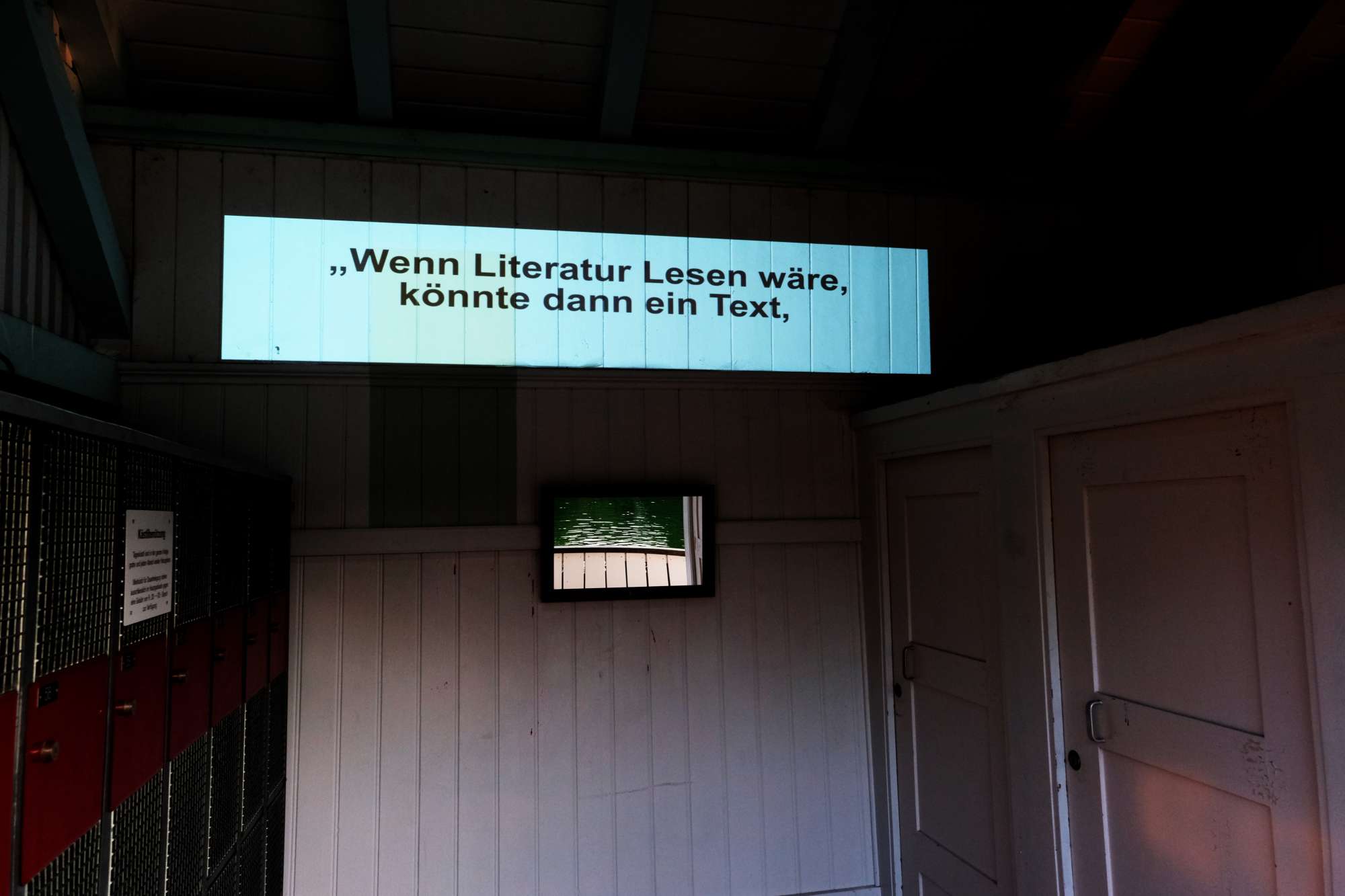
Bedenken, Teil 1: Sprache (Deliberation, Part 1: Language), 2020, 3 min 34 sec
Bedenken, Teil 2: Literatur (Deliberation, Part 2: Literature), 2020, 3 min 39 sec
Bedenken, Teil 3: Ideologie (Deliberation, Part 3: Ideology), 2020, 4 min 50 sec
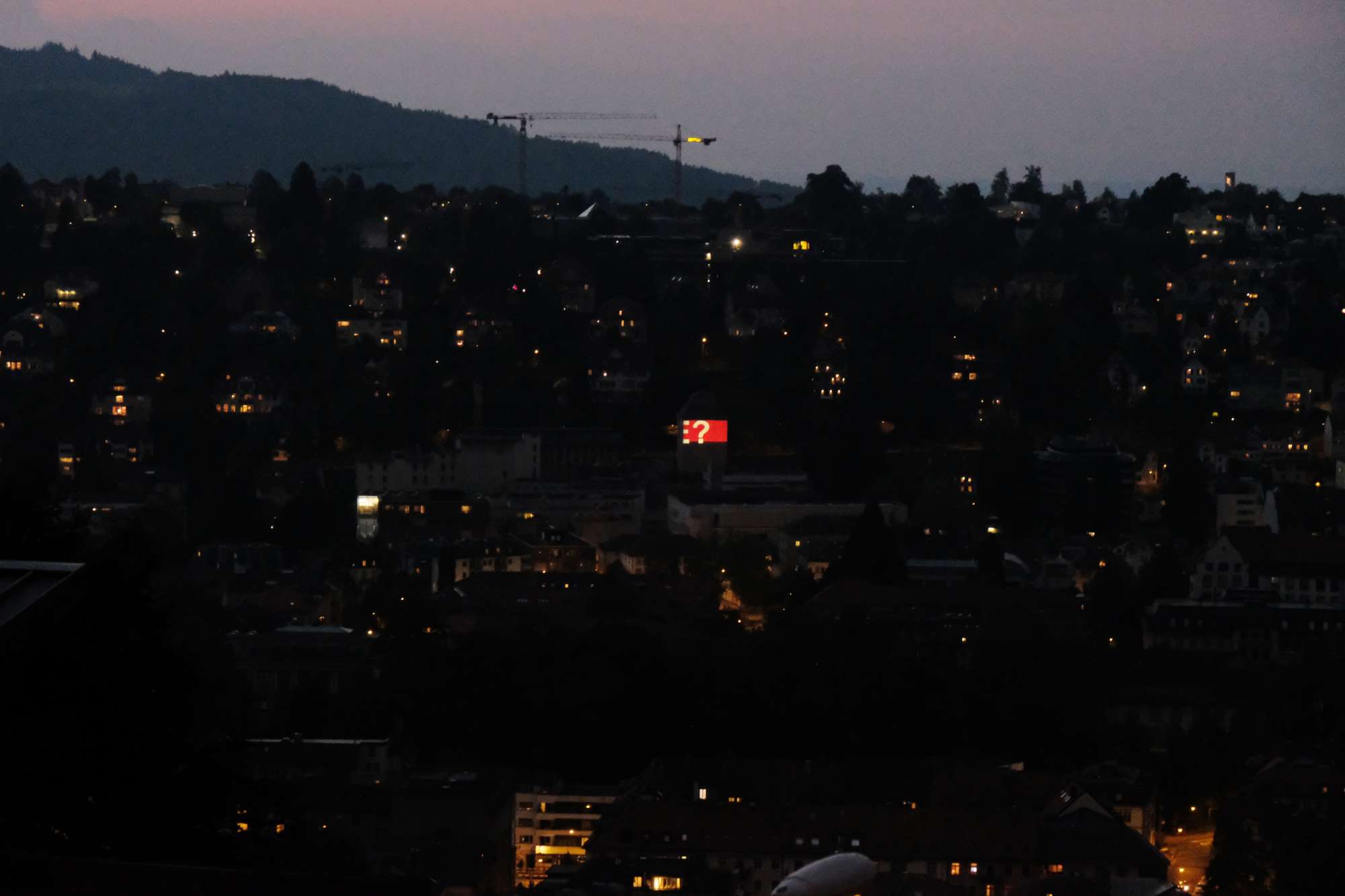
In their work, Michèle Graf and Selina Grüter explore social relationships and the conditions under which interaction occurs. In stadtprojektionen IV, the pair are represented by a three-part text piece. Each part raises a question and emanates from an understanding of language as dialogue, as activity and as practical awareness. The three parts can be seen at Frauenbad Stadthausquai in Zurich and at/from Drei Weieren in St. Gallen.
In Zurich, the projection Bedenken, Teil 1: Sprache (Deliberation, Part 1: Language) by Graf and Grüter is situated at the edge of a recessed pool, just above the water’s surface and below the plateau where an audience presents itself in the evening. The question asked here is: What is language?

In St. Gallen, the artists are showing two projections: The projection Bedenken, Teil 3: Ideologie (Deliberation, Part 3: Ideology) provides a distant view of a 1920s silo at the Schützengarten brewery and creates an open field of associations beyond the city. Here, Graf and Grüter ask: What is ideology? The projection Bedenken, Teil 2: Literatur (Deliberation, Part 2: Literature) refers to pre-existing written signs at the bathing pavilion that can be found on the long edge of the lake Mannenweier. These include phrases like: ‘Pure on the outside, pure on the inside. Pure the speech, pure the meaning.’ The artists respond to these written signs, whose author and year of origin are unknown, addressing the question: What is literature?
Michèle Graf and Selina Grüter studied at ZHdK and have been collaborating since 2011. Their work is often performance-based and they prefer spatial situations with no clear separation between stage and audience. Often, the nature of this (non-)boundary is precisely what they investigate in their works. They are currently participating in the Whitney Independent Study Program in New York.
Älskarna (The Lovers), 2014, 6 min. 39 sec.
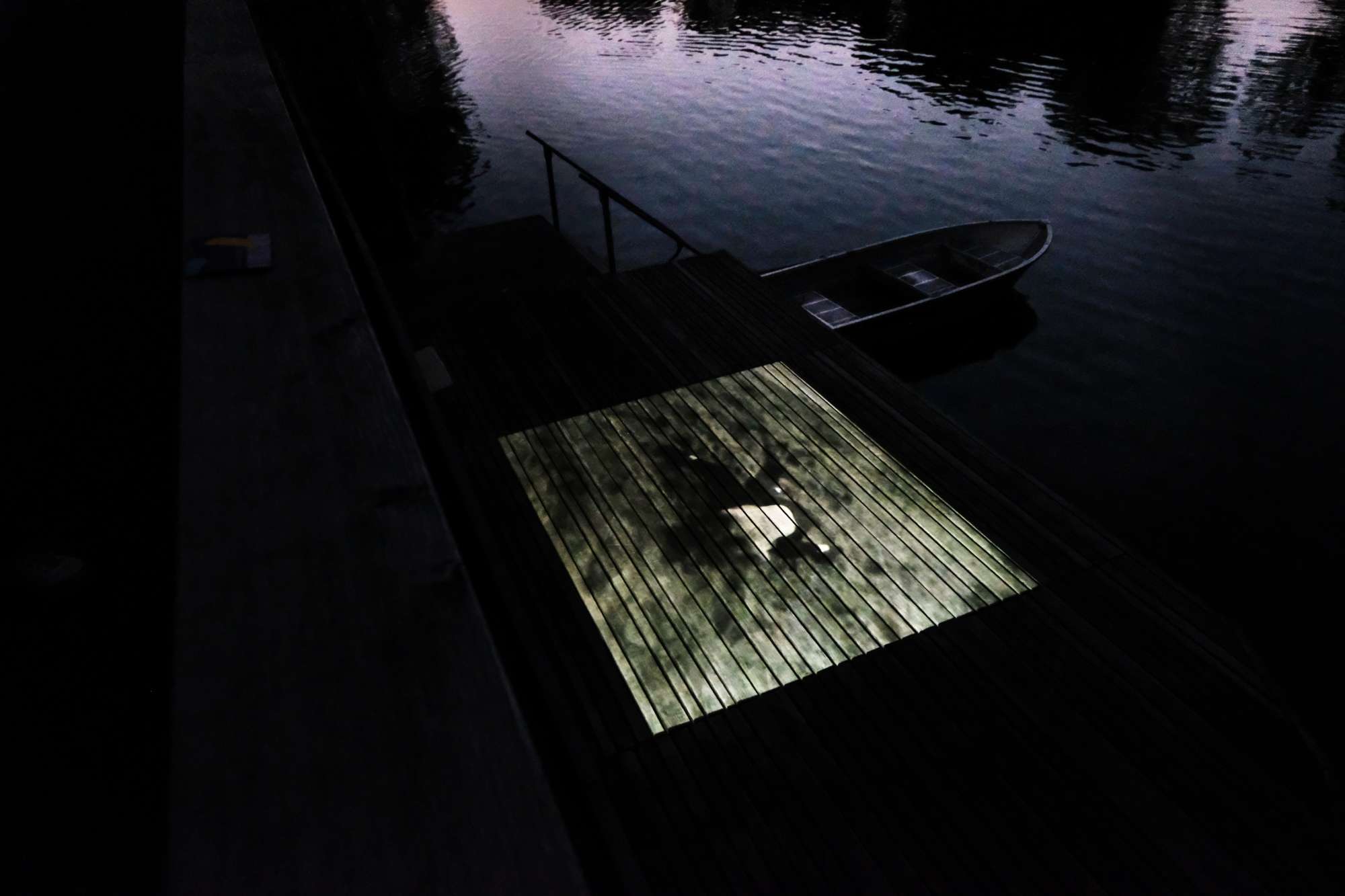
Lisa Grip presents the film piece Älskarna (The Lovers), in which her current partner fights her former partner on a beach. This is not a fight in the traditional sense, but oscillates between playing, tussling and hugging – a situation that can sometimes be observed in summer at the nearby playground to the west of the lake Mannenweier. The projection takes place in the bathhouse on the long edge of Mannenweier – from the gallery, down to the wooden platform near the water. The bird’s-eye perspective of the projection matches that of the film piece. Älskarna was made as an analogue Super-8 film and its graininess is captivating.
In her work, Lisa Grip reflects on the intimacy and the balance of power found in interpersonal relationships. She sets scenes in motion by first issuing directorial instructions, then giving the protagonists free rein. Thus, her way of working is often about control and the desire to lose it.
Ghost Nets, 2015, 1 min. 22 sec.
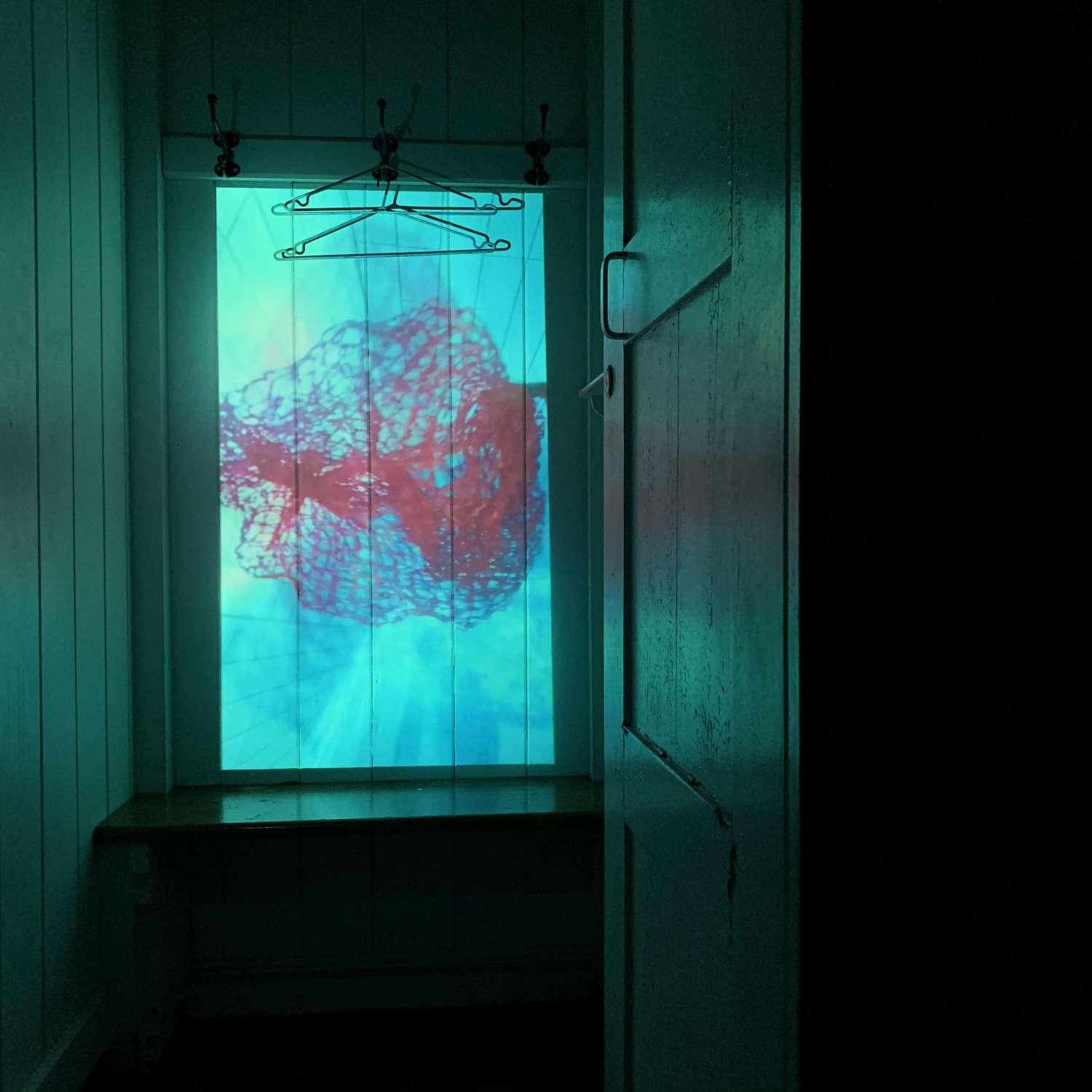
A deep-red mandarin net dances across a bright-blue swimming pool. In the background, more net clumps become visible, which obviously do not belong in the swimming pool. These are cross-fades of shots from the world’s oceans, where huge fishing nets bob along. Sonja Lippuner captured them on camera while diving, repeatedly pointing the camera up at the water’s surface, through which the sun glitters.
In a manner that is gentle but simultaneously precise, this artist identifies the great threat that waste poses to the ecosystem. Sonja Lippuner loves to dive and swim – in all the world’s oceans and often in the lakes at Drei Weieren. In so doing, she experiences the sensation of physical freedom: a lightness that has disappeared from her everyday life, due to her being confined to a wheelchair. Underwater views and fish motifs recur throughout her work, regardless of whether the medium is photography, painting or sculpture.
With its floating lightness, the mandarin net brings to mind the white plastic bag in Sam Mendes’s film American Beauty (1999): The moment when a piece of rubbish is seen to perform a delicate dance with leaves is breathtaking. Like Sonja Lippuner’s mandarin net, this key scene in American Beauty opens up a range of meanings, swinging back and forth between beauty and tragedy.
Dance exercises at Lago Maggiore, photographer unknown, 1913
© Munich City Library / Monacensia
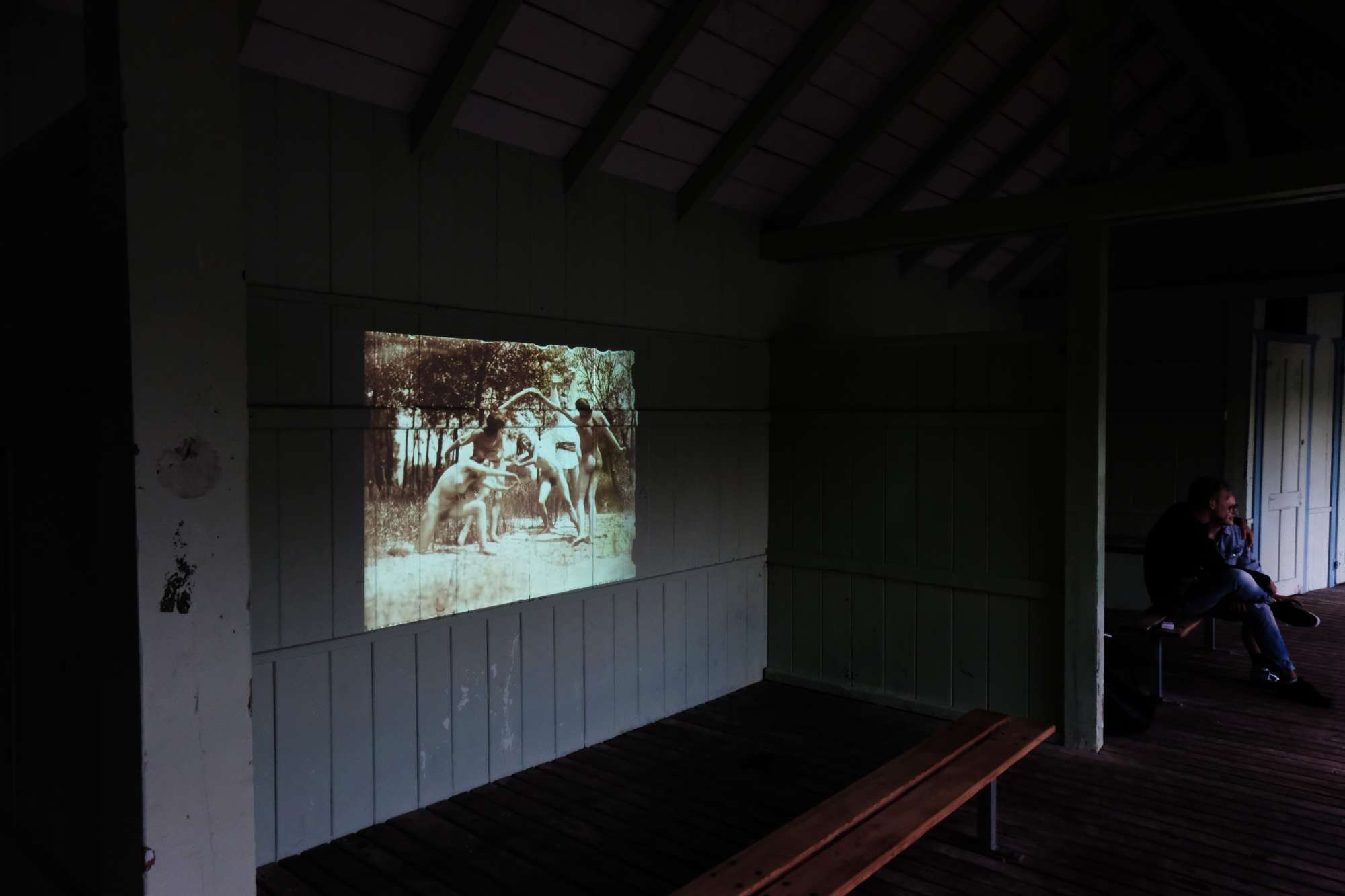
A projection in the open-plan bathhouse at the eastern end of the lake Mannenweier attracts attention from afar. Here, stadtprojektionen presents a photograph of dance exercises, taken in 1913 at Lago Maggiore. The still image captures the free-spirited and communal atmosphere associated with bathing facilities. We see five people dancing, partly naked. Among them is Rudolf von Laban, founder of expressionist dance, pioneering dancer and choreographer. In the 1910s, Laban lived and worked on Monte Verità near Ascona, where he ran a dance school in affiliation with the local sanatorium. He wanted his students to find ‘pure’, individual, non-preformed, expressive motion and learn to convey emotions through movement. Laban’s aspiration was for life to be reformed in connection with dance and movement – and if possible, this reform was to be conducted outside, barefoot and naked.
It cannot be assumed that any dancing based on Laban’s ideas took place at Drei Weieren around the year 1900. At least, there is no evidence of it. However, an opening did manifest itself here: Although the Drei Weieren lakes were created around the year 1610 for bleaching canvas and to provide water reserves for firefighting, they slowly developed into a bathing and recreational area in the 18th century. Finally, around the year 1900, their current use was cemented by the construction of several bathing facilities, which were gender-segregated and therefore spread as far apart as possible across Drei Weieren.
Intermediate states, 1995-2015
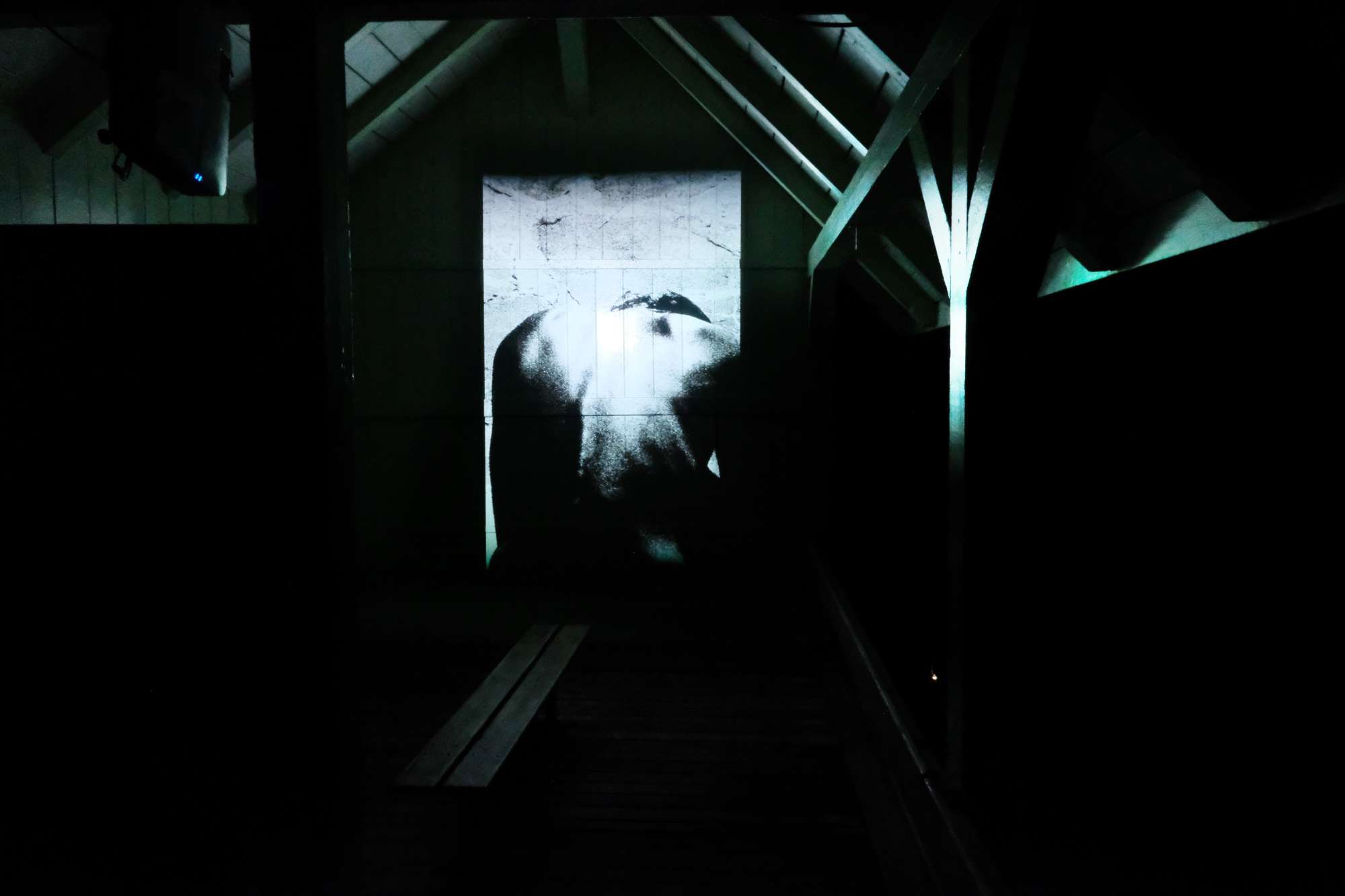
In an intimate place that can only be accessed via a footbridge, Michèle Mettler presents her black-and-white photo series based on the human body. Faces, torsos and dorsal nudes appear, but often in an unrecognizable and ghostly manner: They are in shadow or a kind of fog and thus only vaguely perceptible. The photographed people emanate a sense of calm, developing a presence that is sometimes sensual and alert, sometimes entranced and floating. The photographs, taken between 1995 and 2015, were adapted by the artist many times over: Mettler made holes in them, cut into them and photographed them again, or created double exposures on photographic paper.
Michèle Mettler’s photo projection can be seen in the half-open lateral building constructed in 1906 at the eastern end of Mannenweier – in what is otherwise a changing area, shielded from view by a striped sailcloth.
Michèle Mettler works with photography and drawing. She is currently involved in a project about migrants’ gardens and also working on an acupuncture series, in which she colours her model black and traces the meridians, i.e. the pathways of vital energy. This artist is interested in quantum physics, intermediate states and the invisible. She is trained in Chinese medicine, which influences her photographic works.
Densen, 2009, 7 min. 20 sec.
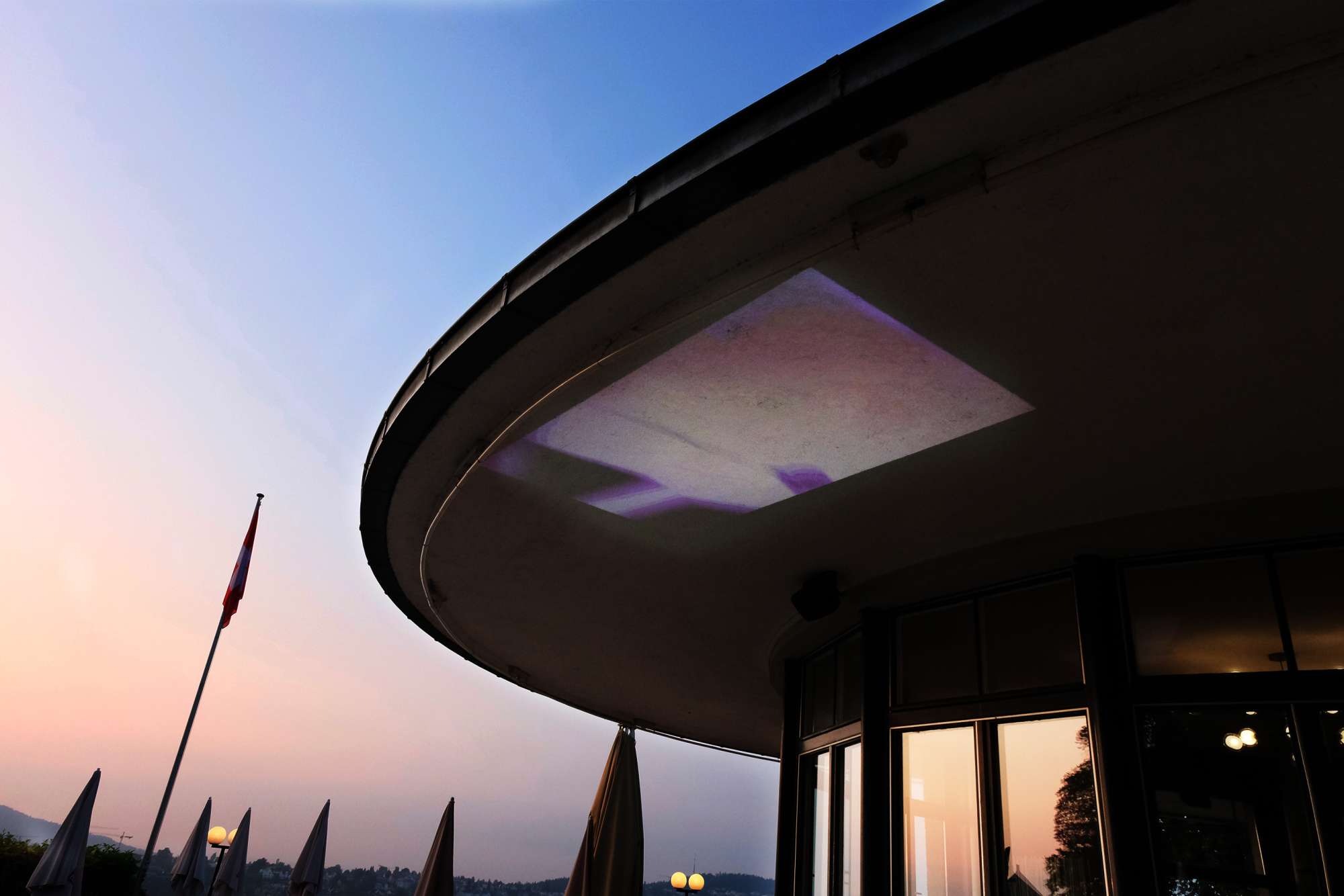
The film collage Densen by Anna Linder is based on photographs from Tokyo, St. Petersburg, Barcelona, Milan and Buenos Aires. The artist animated them manually in a complex procedure to a film: Sometimes the focus is on one photograph, sometimes the view is vague or the images swirl in a circle, then another zoom-out shows an organised collection of photographs. What Linder’s photographs have in common is a skyward gaze. Cropped skyscrapers, traffic lights and pylons can be made out, their wires diagonally cutting across the photographs again and again.
Densen (a Japanese word, meaning power line) is projected beneath the overhanging roof of the restaurant Dreilinden. The direction of the viewers’ gaze matches that of the film collage. The restaurant Dreilinden was built in 1932. Its flat roof, cubic main body and semicircular annex make it an important representative of the New Objectivity style in St. Gallen. The Densen projection at Drei Weieren also makes reference to the moment when someone emerges from water, head outstretched, still perceiving the surroundings as a blur and trying to direct their gaze again.
Since the early 1990s, Anna Linder has been working with the moving image, be it as an artist, curator or producer. Active in the LGBTQ community, Linder produced the experimental film Spermwhore in 2016, in which she addresses the unwanted childlessness of homosexual couples. In the same year, Linder launched SAQMI, the Swedish Archive for Queer Moving Images, located in Gothenburg.
Loose Legs, 2020, 10 min. 31 sec.
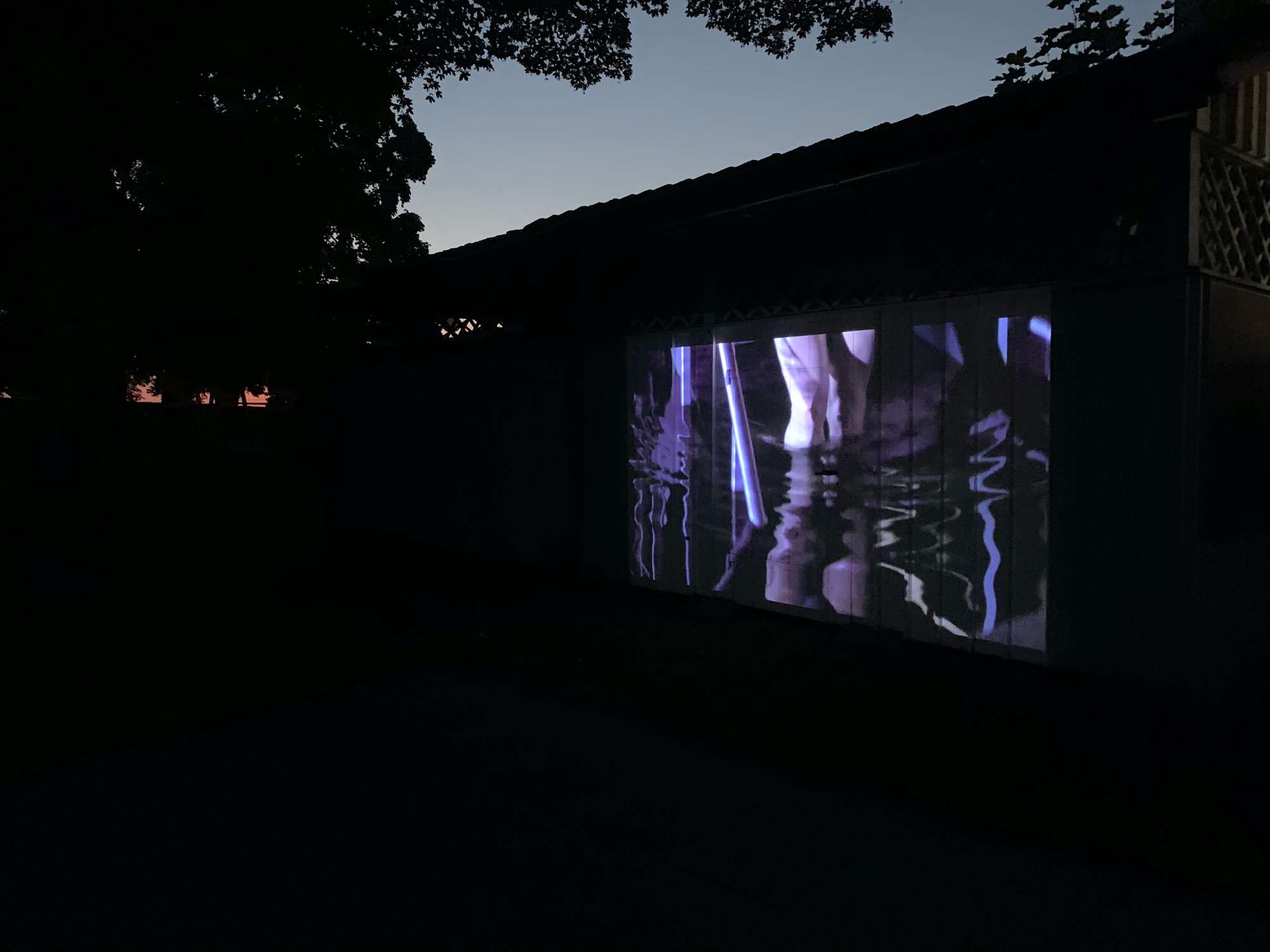
This August, artist duo Rico Scagliola & Michael Meier filmed under a full moon at Drei Weieren. The film shows legs appropriating the architecture of Frauenbad: They carry out movements resembling synchronised swimming in the recessed pool, present themselves on the lawn and gracefully march over the wooden walkways. At Frauenbad, a swimming facility built for women in 1896 and shielded from the outside world, the legs also venture into forbidden areas, dangling from the window of the bell tower and crawling on wooden partitions as the water glistens in the moonlight.
Rico Scagliola & Michael Meier live in Zurich and have been working together since 2008. Sound, film and photography accompany their work. They are concerned with the construction of identity, with self-expression and with social belonging. The duo closely observe individual and social behaviour. The film piece that they have created for stadtprojektionen IV is motivated by the following questions: What kind of behaviour does a bathing facility provoke in us? What role does architecture play in this regard? Their film piece Loose Legs addresses stereotypical gazes: “It is about the image of legs,” say the artists, “reproduced and eroticised by the media, usually seen in the form of women’s legs. In our film, the legs that appear, which are our own, are detached from the upper body and made independent. This gives them a spooky, identity-lacking quality, while they (re)present patterns of movement that are sometimes erotic, sometimes artistic, sometimes mundane, in an endless loop.”
Mother’s Milk, 2019, 14 min. 23 sec.
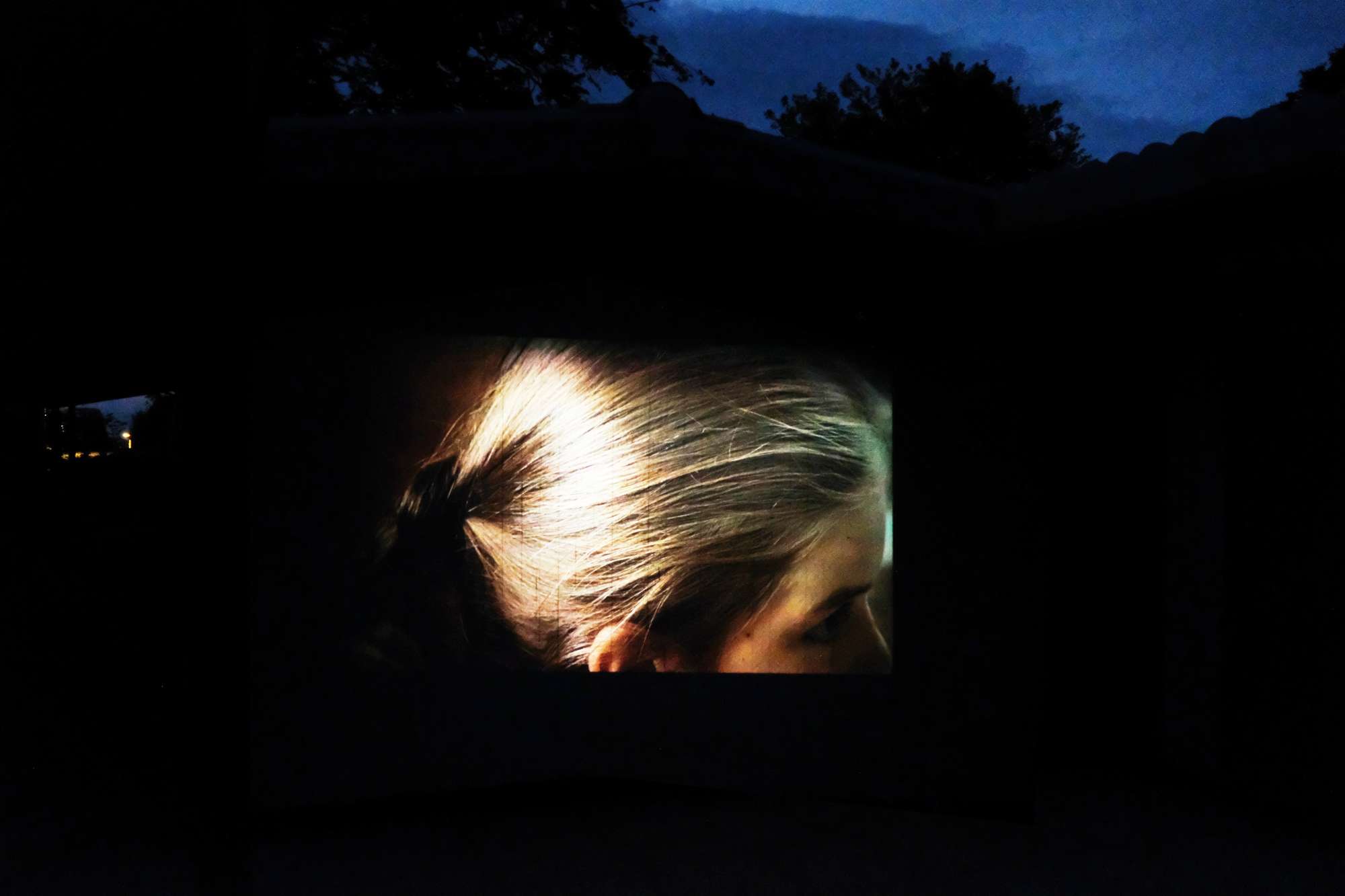
In the film Mother’s Milk, Sophie Vuković sheds light on a relationship between mother and daughter. Gestures that are exchanged again and again over the course of a day are examined in close-ups. This portrait, as poetic as it is clever, reveals loving and ruthless aspects alike. Above all, the film draws attention to the fact that, for decades, there was little questioning of the social norm that women took care of the household and children.
Mother’s Milk is shown at the family bathing facility Familienbad, which is firmly a mother-daughter place. The projection’s intimate location is by the changing-room structure from the mid-1950s, which sways back and forth. St. Gallen’s struggle to set up a family bathing facility began in the 1920s. It was not until 1943 that the city council decided on temporary use of the women’s lake Frauenweier for family bathing. Finally, the Chrüzweier community bathing facility was officially opened in 1956.
Sophie Vuković is a filmmaker and artist whose work deals with the construction of identity and often with migration as well. She investigates how personal experiences are determined by social and political structures.
Praktische Arbeit (Practical Work), 2020, 8 min. 12 sec.
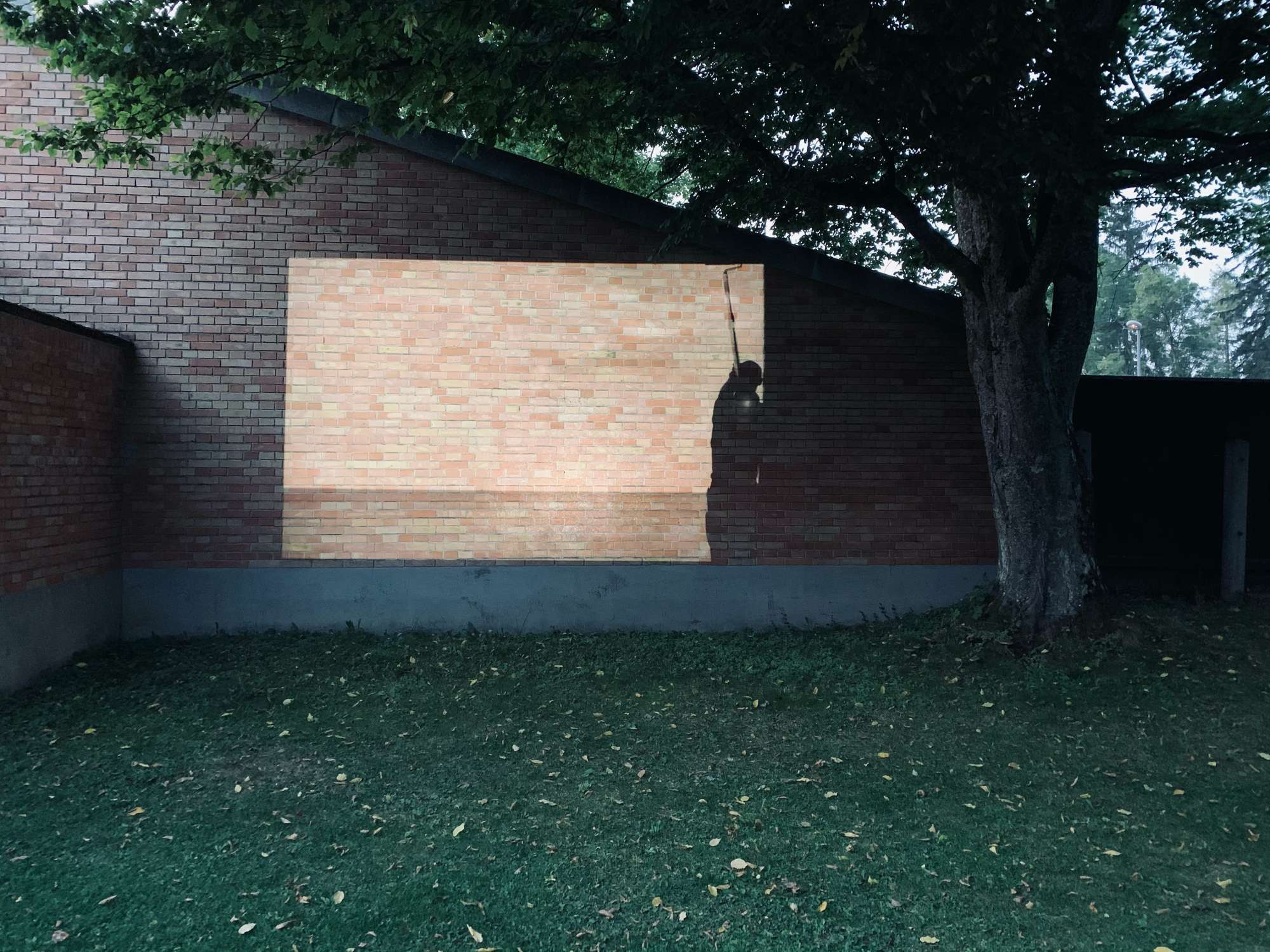
Praktische Arbeit (Practical Work) is the title of Herbert Weber’s film piece for stadtprojektionen IV, conceived on the basis of the brick wall that marks the transition from the family bathing facility to the one reserved for women. The film begins with a black surface, which only gradually becomes visible as it is painted over in white. What follows is a calming view of the North Sea. The artist makes reference to the sea as a place of longing, as well as to the fact that the water from Drei Weieren flows via the Steinach River into Lake Constance, then into the Rhine and finally into the North Sea. However, the poetic view is not always present – seas also have their dark sides. “The sea also represents terrible realities,” says the artist in a 2019 interview. “Refugees drown in it, it is overfished and tonnes of rubbish float around. These circumstances might ultimately replace the poetry of the sea. Hopefully, its beauty will prevail for a long time to come.”
Herbert Weber lives in St. Gallen and frequently swims at Drei Weieren in the summer. The starting point for many of his works is the respective exhibition situation. He addresses the spatial constellation, encouraging the observer to reflect on their own point of view and perhaps even to shift it. In Praktische Arbeit, he contemplates water cycles and, via the act of applying a coat of paint, shows that it is up to us to be more careful with the Earth and its resources.
Knutschen allein zu Hause (Smooching Alone at Home), 2020, 1 min. 42 sec.
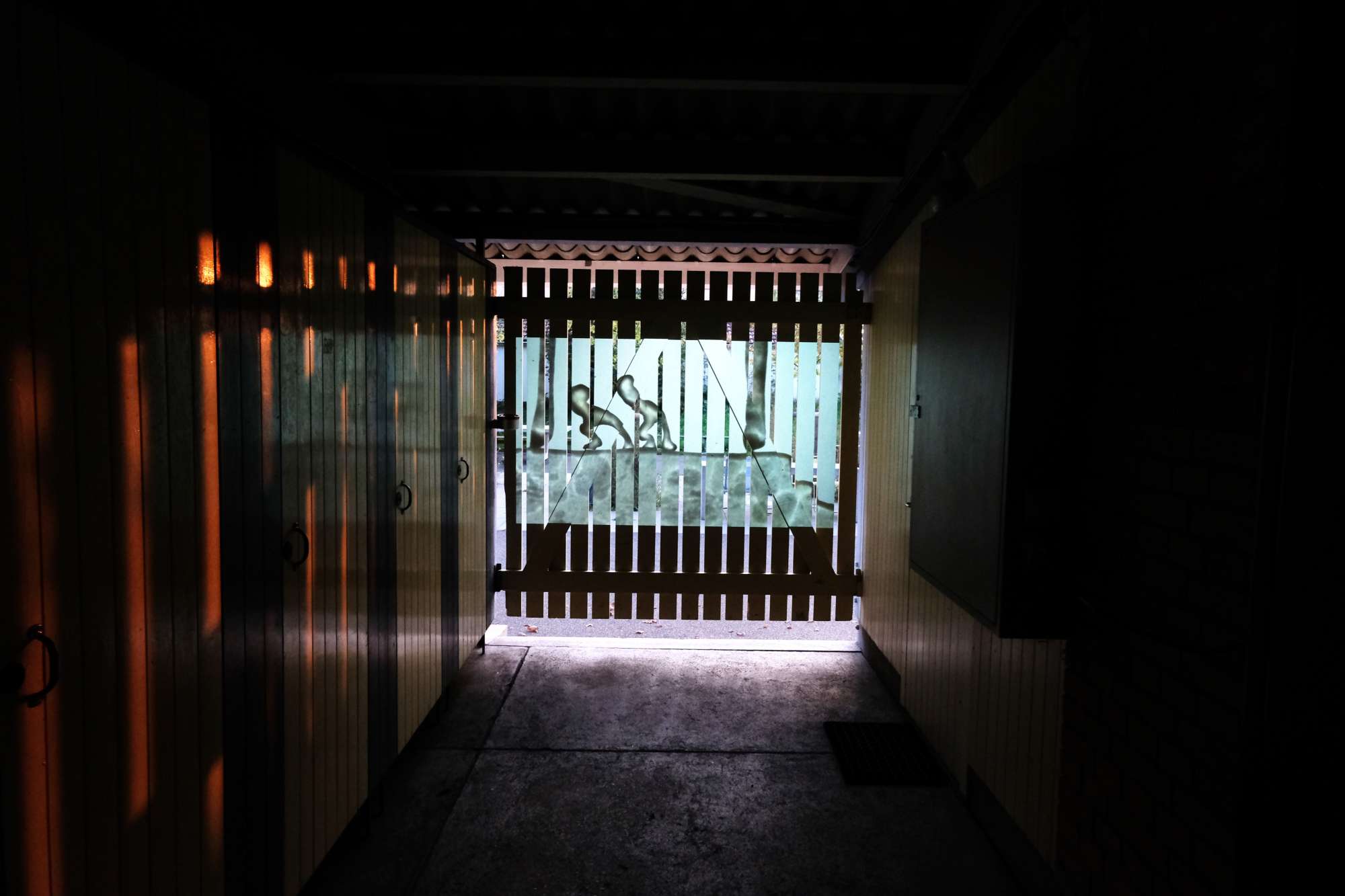
Figures smooch near a lake and go swimming. Terrestrial and aquatic animals blend together and become algae. Bertold Stallmach charmingly plays with the tremendous feeling of touching in water, which probably everyone knows from childhood and nobody can ever completely outgrow. This work is projected onto a door made of wooden slats, through which it penetrates. This piece by Bertold Stallmach at the entrance to the family bathing facility Familienbad resembles how leaves, fish and algae can be made out on the water’s surface in lakes.
This animated short story about two lipids swimming in a lake is the result of an attempt to depict neural activity. Bertold Stallmach animated the figures using transparent modelling clay. A single dab of colour appears in the black-and-white film; it is yellow and represents a sodium atom trying to penetrate the lipid bilayer.
The site-specific piece Knutschen allein zu Hause (Smooching Alone at Home) was created for stadtprojektionen IV during the lockdown. Thus, the yellow blotch could also be read as a virus. On a neural level and, equally, on the level of current world events, the film touches on the fluid boundaries between real and imaginary, between collective and personal dangers and their effects.
Bertold Stallmach operates within the media of animation, collage, drawing and installation. Using playful wit, he thematises interpersonal entanglements and dependencies. Childish questions lead to global issues and contexts. “If you always sit at home,” says Bertold Stallmach with regard to Knutschen allein zu Hause, “you simply don’t get around to playing footsy with sleeping monsters often enough.”
Knutschen allein zu Hause is being shown in both St. Gallen and Zurich. At Frauenbad Stadthausquai, this work is projected into a changing room and can be viewed in a cinematic manner from the opposite side of the pool.
Fluidum II, 2019, 1 min. 41 sec.
Fluidum III, 2019, 3 min. 52 sec.
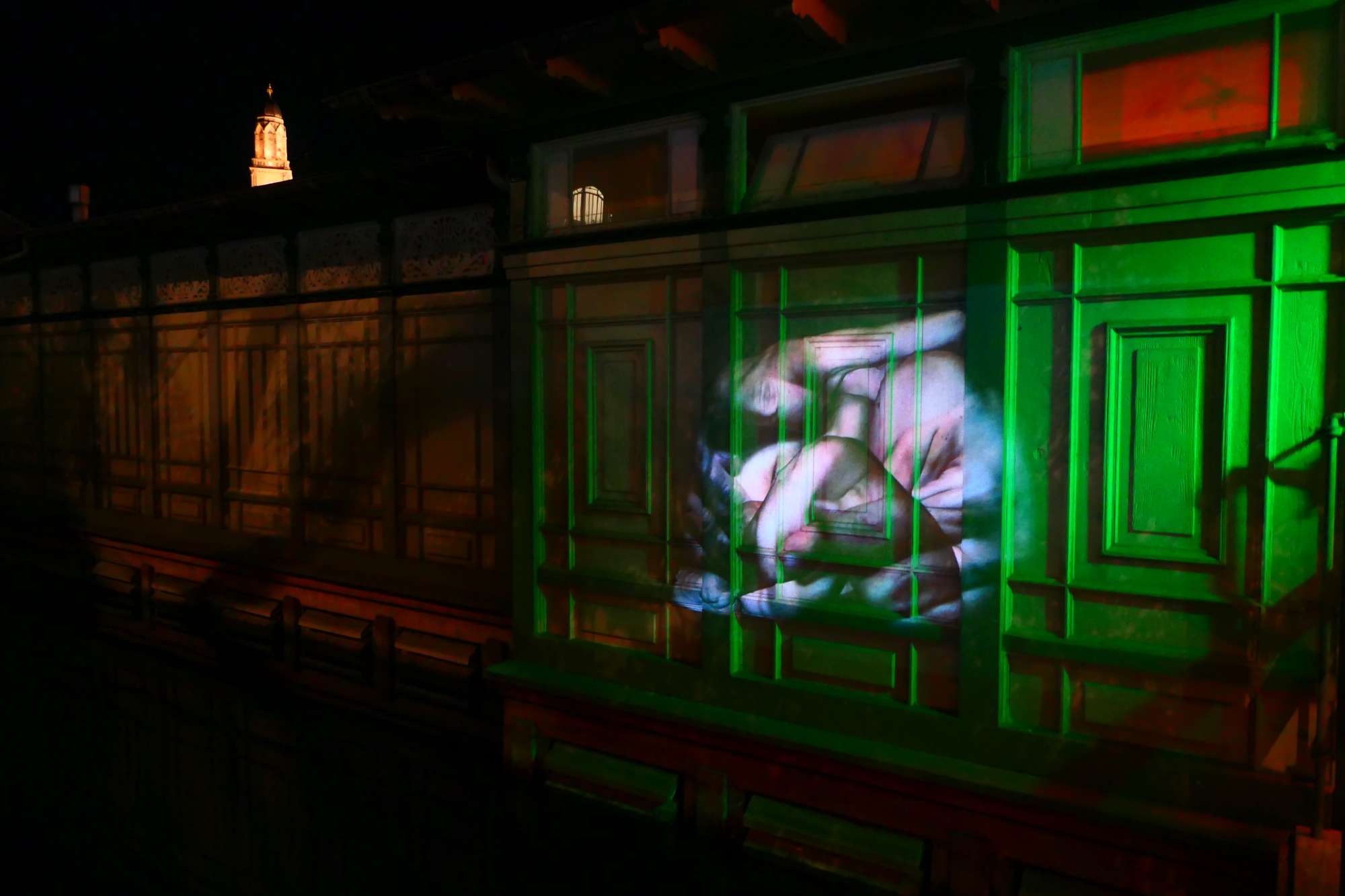
Fluidum II, 2019, 1 min. 41 sec.
Fluidum III, 2019, 3 min. 52 sec.
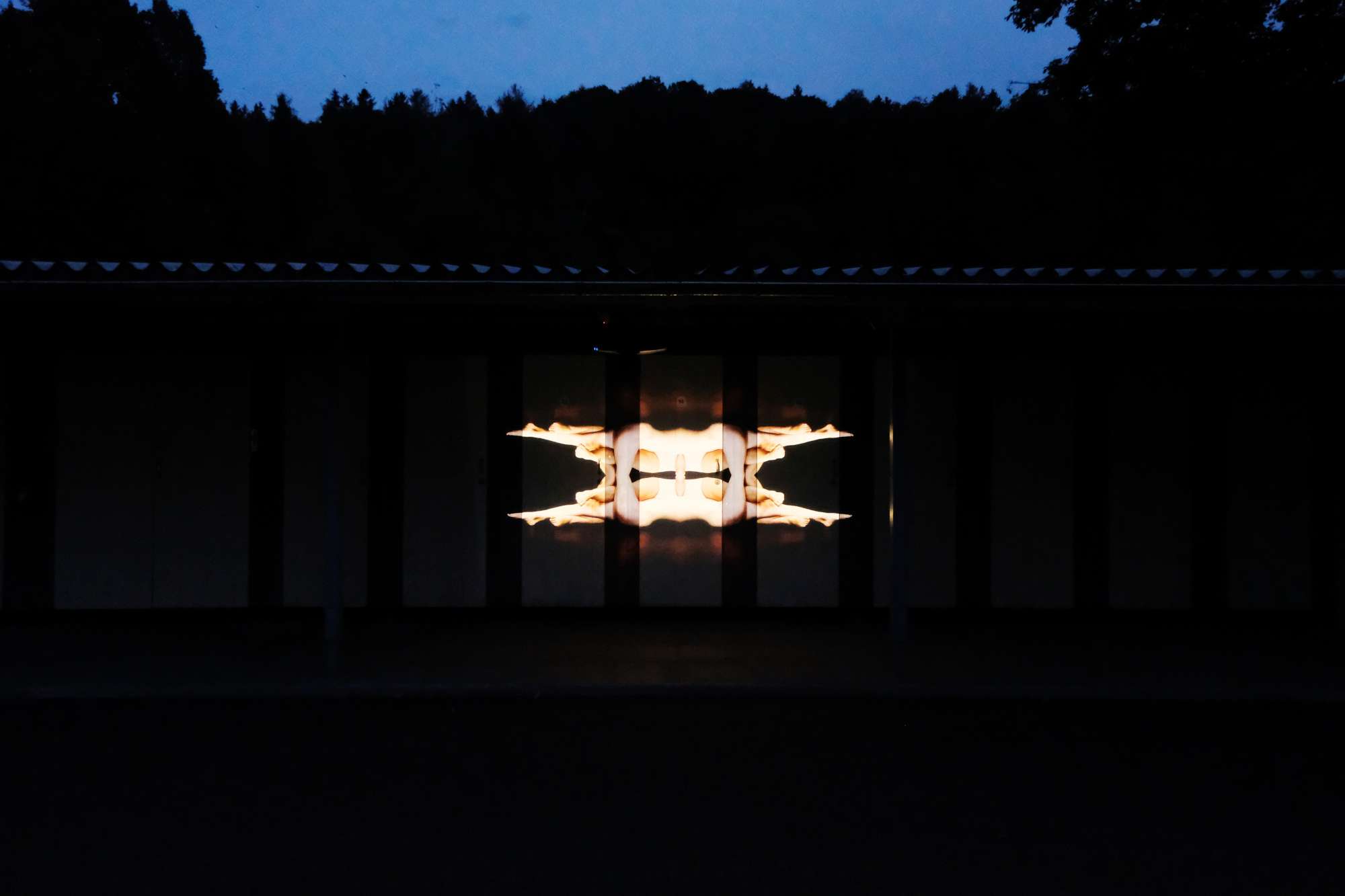
A kaleidoscope of limbs opens the spectacle of stadtprojektionen in the family bathing facility Familienbad at Drei Weieren. Body parts stretch and loll across three changing rooms. In a permanent flow of emerging arms and legs, new abstract corporeal visual worlds keep opening up. Right behind the projection at the changing rooms, there is a closed bathing area reserved exclusively for women.
This work is from a four-part series by the artist duo BIGLERWEIBEL. With different focuses, Fluidum (Aura) shows fragments and combinations of two bodies – those of the artists. Here, they counter the female body as perceived in everyday media, adeptly reducing it to form and materiality.

BIGLERWEIBEL consists of Jasmin Bigler and Nicole Weibel, who have been operating as a duo since 2014. Their works are characterised by a fundamental feminist stance. All work steps are planned and executed by the duo themselves. The female body serves as a starting point, from which to enhance its optical potential. The duo interweave performance with digital media, thematically revolving around non-places, physical irritations, symmetries, normalities and defamiliarisations.
During the prelude to stadtprojektionen in Zurich, a clump of bodies welcomes us on the outer facade of Frauenbad Stadthausquai. In Fluidum II, two hands kneading a belly are superimposed on hunched-up female bodies. Fluidum II witnesses an intimacy and almost evokes a cramped sensation, whereas in Fluidum III, which is projected in St. Gallen, two female bodies assert themselves confidently.
The ANI association welcomes financial support for future stadtprojektionen:
Vereinskonto ANI – Verein für kuratorische Projekte
St.Galler Kantonalbank
IBAN CH88 0078 1623 1108 8200 0
Many Thanks to the artists and our team:
Technik: Clemens Waibel, Bastian Lehner und Gianluca Trifilo
Grafik: Roland Brauchli
Website: Jonas Huber
Übersetzung: Simon Thomas
Thank you! The fourth edition of stadtprojektionen is generously supported by: